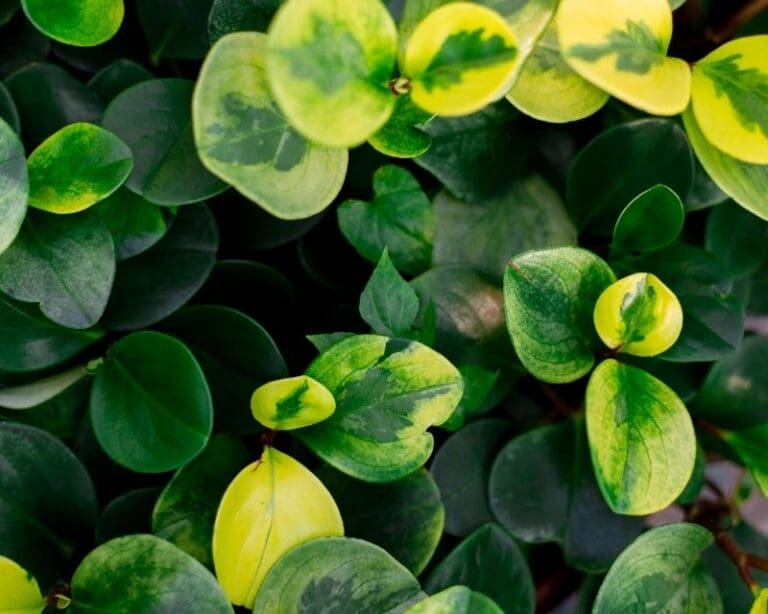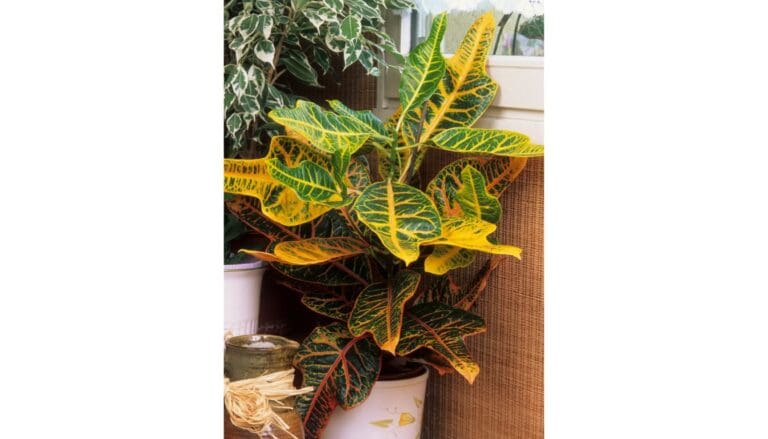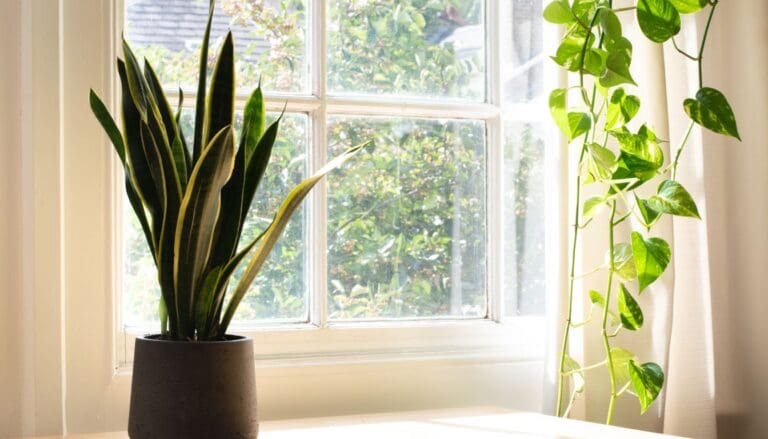How To Care For Peace Lily In Winter? (Peace Lily Winter Care)
The peace lilies are tropical plants that have gained popularity as houseplants due to their dark green foliage, white blooms, and air-purifying abilities. The owners need to keep in mind that the peace lilies need special attention during winter as their requirements change as per the season.
So, in this article let us learn how to care for peace lily in winter.
To care for peace lily during the winter, you need to make the following adjustment in their daily care regime:
- Peace lilies might not get enough sunlight during winter, so you can use artificial light to supplement their lighting requirements.
- Avoid watering with cold water and use room-temperature water to water your peace lily.
- Always check the soil before watering. Make sure you let the soil dry out between watering.
- Do not let the temperature go below 40°F as that can cause severe damage to the plant.
- Try to maintain the ideal humidity with the help of a humidifier.
- Stop fertilizing the plant during winters.
- Keep the plant away from cold drafts.
If peace lilies do not get proper care in winter, they can develop wilting of leaves, discoloration, overfertilization, etc.
Let’s look at some problems your peace lily can face during winter and how you can provide the correct winter care to your peace lily plant.

Please note: Simplify Plants is reader-supported. Some links in the post are affiliate links and I get a commission from purchases made through links in the post.
Common problems of peace lily in winter
Peace lilies come from tropical lands and, naturally, don’t do well in winters. They do not show any difficulty in temperatures above 45°F and continue to remain healthy. If the temperature drops below 40-45°F, the peace lilies start showing problems.
The care routine of the peace lily during the summer and the springtime is different and should be discontinued in the winter season. You might be unintentionally killing your peace lily by doing the same things in winter.
Wilting of the peace lily
Overwatering and underwatering are common in winter. Wilting is a severe issue and should be dealt with with the necessary care needed.
Peace lilies are delicate and wilt if left underwatered for several days. Sometimes the cold air carries away all the moisture and makes the plant dry, leading to wilting.
Overwatering results in permanent wilting as due to the unavailability of enough direct sunlight in winter, the plant does not lose much water. If you continue watering it like the other seasons, you will end up with an overwatered peace lily that wilts.
Yellow leaves
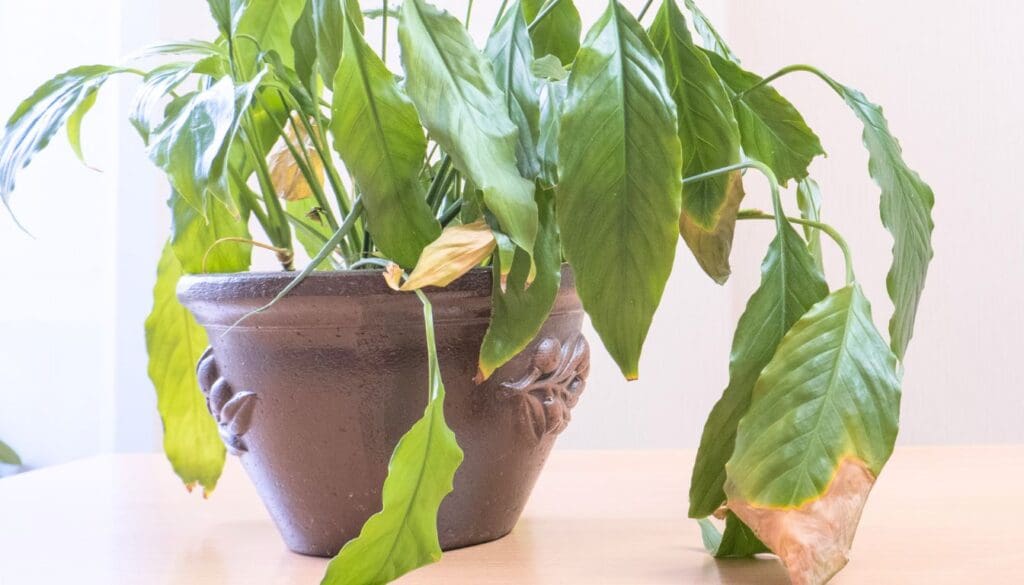
Overwatering is considered the main reason behind the yellowing of the leaves. The sudden change in the environment from high to low temperatures can trigger the plant, resulting in the yellowing of the leaves.
The temperature plays a vital role as the peace lilies do not like low temperatures. Any temperature below 40°F can result in wrinkling and yellowing of the leaves.
The correct temperature for peace lily is between 65-80°F as it grows the best in this range.
Brown leaves
Underwatering and lack of humidity result in brown leaves. You notice the brown leaves when you place the peace lily under direct sunlight to protect it from cold air.
The running water of the house can also be responsible for brown leaves as it contains a chemical called fluoride, and it causes the leaves to become brown. But you can fix this by using distilled water or purified water for watering your peace lily.
The peace lily needs humidity, and this becomes a problem on dry days. Air is generally very dry in the winter months. Therefore, you can use a humidifier to keep the air moist. It keeps the peace lily healthy and helps avoid brown leaves in winter.
Over-fertilizing the peace lily
Over-fertilization is one of the leading causes of the poor health of the peace lilies. The under-fertilized plants can recover easier than the over-fertilized ones.
A balanced fertilizer should be used while fertilizing the peace lilies. But it would help if you stopped it at the beginning of the winter and resumed it in late winter. If you continue following the same fertilizing routine in winter, the plant will damage overfeeding.
Fertilizing once in 6 weeks starting from late winter will help your peace lily bloom in summer and spring.
Pest infestation
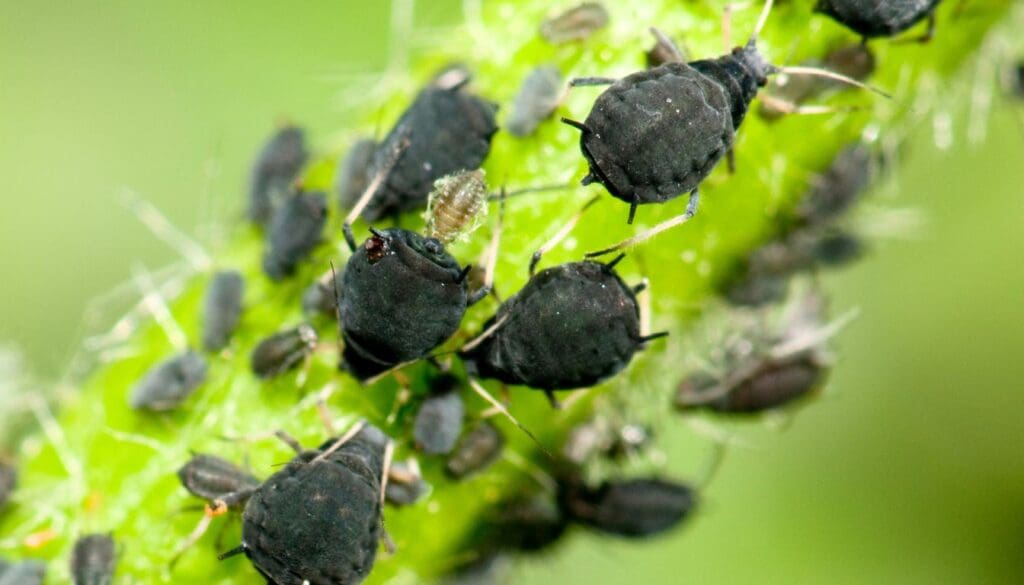
Peace lilies are most prone to pest infestation in winter when the light is least intense, low temperatures, and less moisture in the air.
Not watering the peace lily correctly or not letting the soil get dry will create the ideal environment for pests, and they will feed on your peace lily, making it weak. You might notice pests such as mealybugs, scales, aphids, etc.
Therefore, taking proper care of peace lily during winter is more important as this is not the best recovery time for these plants.
Also read: Do Peace Lily Attract Bugs? (Identification+How ToGet Rid Of Them)
Winter care of peace lily plants
The peace lily can become delicate in the winter season. The sunlight is not adequate for the plants, which affects their overall metabolism and reduces their growth.
This might not be a problem but being more careful and changing the care routine in winter becomes more crucial.
The factors that affect peace lily in winter
Let’s check the factors that affect the peace lily plant’s growth in winter and the correct requirements that you need to keep in mind.
Light
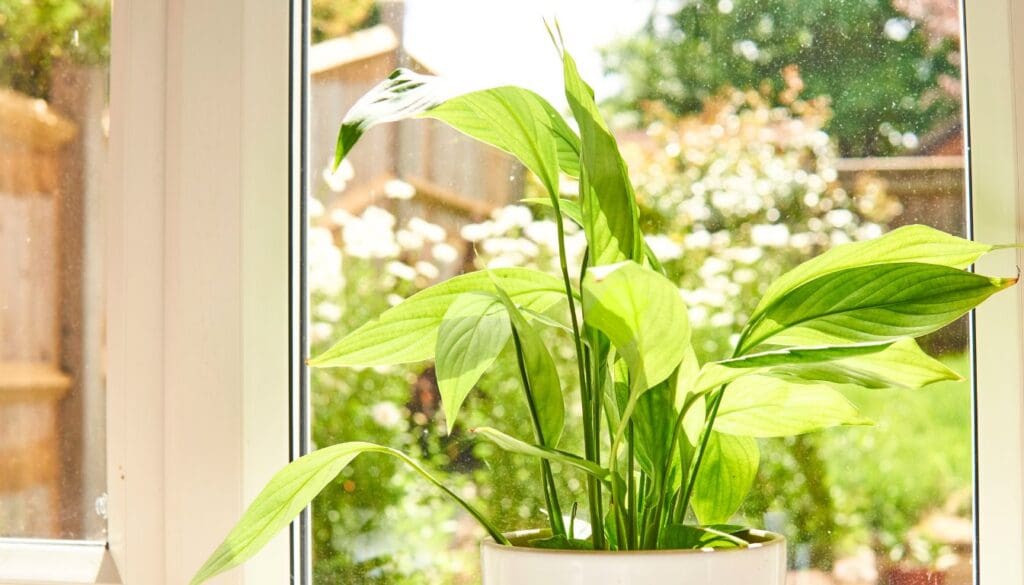
Light is an essential criterion, especially for plants, as they depend on light for their survival. The winter comes with insufficient light that leads the plant to dormancy.
You should find a spot for your peace lily that gets the most amount of light in winter and relocate the plant to that spot. You can even let the plant be under direct sunlight for a few hours in the daytime during winter.
However, do not place the plant in front of the window during winter as that might expose it to low temperatures or cold drafts that are very detrimental to the peace lily.
In winter, you can use artificial lights to provide extra light to your peace lily, but that might not be required if you have a healthy plant that is already doing well.
Also read: What Kind Of Light Does A Peace Lily Need? (Peace Lily Light Requirements)
Water

Water is a fundamental requirement of all houseplants, but the requirements change during the winter season. The plant doesn’t get enough light, so the soil takes longer to get dry.
You must reduce watering your peace lily in winter and wait for the soil to dry out. If you provide artificial light and some extra heat to your peace lily in winter, the soil will get dry faster, and the plant will require a bit more water.
But as a thumb rule, you must not water the peace lily as much as the growing season, like summer or spring. Water your peace lily based on the temperature and light availability and whether the soil is ready for it.
Do not water with cold water as that can shock your peace lily. Use normal room-temperature water for best results.
Also read: How Often Should A Peace Lily Be Watered? (Peace Lily Water Requirements)
Temperature
The peace lilies do not prefer cold temperatures and often die if kept cold for an extended period. The temperature between 45-55°F is tolerable for the plant and should be maintained if you want it to survive the winter.
Any temperature less than 40°F is considered dangerous for peace lilies, and such low-temperature levels can be life-threatening for the plant.
You can provide some warmth to your peace lily by burning woods in the fireplace or using any heating source in the room.
However, you must not place your peace lily too close to any heating source as that can cause damage. Keep some feet of distance between the plant and the heat source.
Humidity
The peace lily enjoys humidity and doesn’t prefer dry air. Low humidity in the atmosphere during winter might result in the leaves turning brown.
A humidifier can solve this problem and help the plant be in a humid condition. You can try to spray some water on the plant’s leaves only if there is scope for evaporation of that water.
You can use a tray with pebbles and water, but you should carefully place the plant on it to avoid water entering the drainage holes.
Also read: Do Peace Lilies Need Misting? (+Ideal Humidity)
Fertilizer
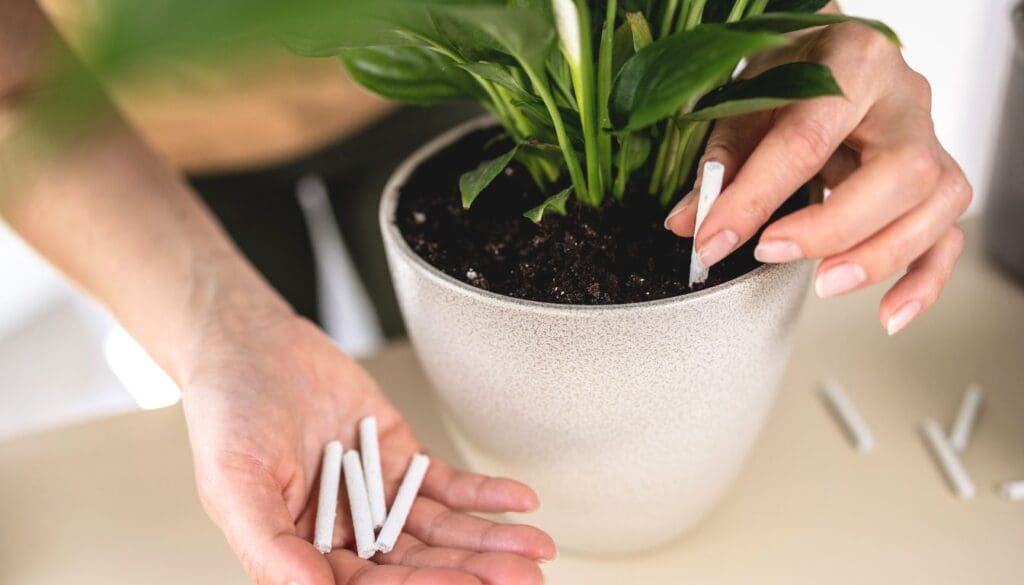
You must not fertilize your peace lily in fall or winter. Winter is the dormant period for the peace lily when it doesn’t focus on growth but stores up energy for growth in the coming spring and summer seasons.
If you fertilize your peace lily in winter, it will get overfertilized due to the excess salt buildup on the soil. Therefore, you must wait for the winter to pass before fertilizing your peace lily again.
Also read: What Kind Of Soil To Use For Peace Lily? (Peace Lily Soil Mix)
Tips for a healthy peace lily in winter
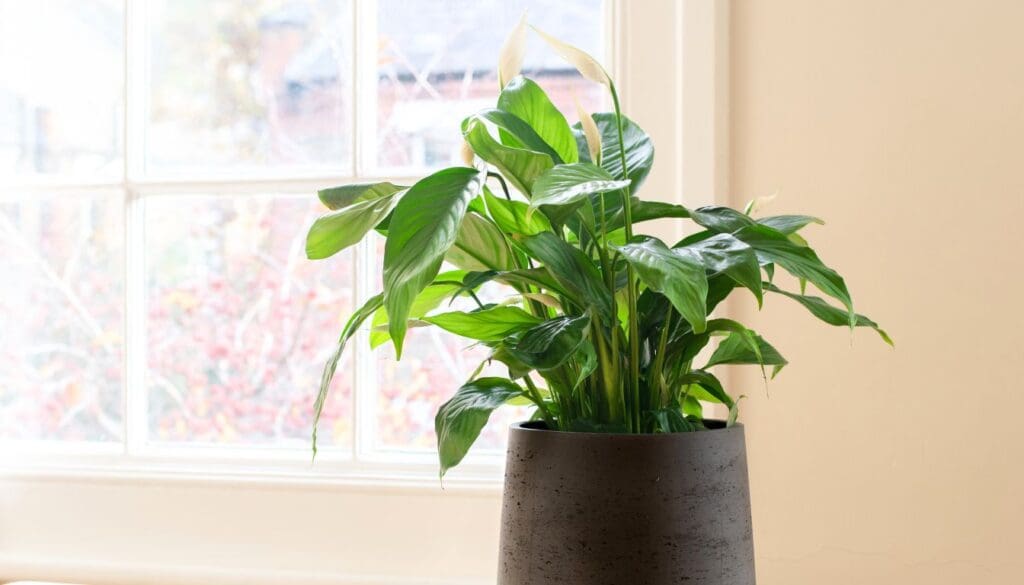
Take a look at these bonus tips that will help you keep your peace lily healthy in winter.
1. You should clean the plant more often.
The dusting of leaves is a must as dust can restrict the light that reaches the plant. The peace lily needs to get some light and heat even during the cold days, which will help maintain a healthy plant.
Not getting adequate heat or light during winter might result in discoloration of leaves along with various other issues.
2. Dropping of leaves is normal.
Winter is when peace lilies shed leaves at a higher rate as they lack proper sunlight, resulting in a shortage of energy.
It can also happen if the plant overgrows and sheds more leaves than usual. Do not worry, as this is just a way to get rid of the damaged or old leaves to grow new ones.
3. Do not prune the peace lilies in winter.
Pruning the peace lilies is essential, but not in winter. Pruning keeps the plant in shape and helps remove any damaged growth, but pruning also causes some stress.
During the growing season, it is easier for the peace lily to recover from the stress of pruning faster, but during winter, it becomes difficult due to the unfavorable conditions.
So, it is best to avoid pruning the peace lily in winter unless it is a matter of life and death.
Final thoughts
Peace lilies are beautiful indoor plants that purify the air. But if you want a long-living plant that survives the winter, you need to take proper care of it.
Winter demands a different care routine, and following the same care routine that you do during the other times of the year will only bring more and more problems to the plant. Therefore, you must adopt a different care routine for your peace lily in winter.
You must try to provide few hours of direct light in the day, reduce the water supply, and maintain the suitable temperature and humidity to keep the peace lily thriving. Do not expose the peace lily to cold drafts and low temperatures, as that can cause irreversible damage to the plant.
Ref: ScienceDirect, NCBI, University of Vermont, Nationalgeographic, NC state university, University of Florida, The University of Arkansas, Queensland Government.
Recommended Garden Supplies
| Product Image | Our Recommended Gardening Supplies | Check Offers! |
|---|---|---|
Top Top
Top
Top
Top
Top
Top
Top
Top | rePotme Houseplant and Tropical Classic Potting Soil Mix | Check Offer On Amazon |
 Top
Top
Top
Top
Top
Top
Top
Top | Espoma Organic Indoor Plant Food | Check Offer On Amazon |
 Top
Top
Top
Top
Top
Top
Top
Top | GooingTop LED Grow Light 6000K Full Spectrum Clip Plant Growing Lamp | Check Offer On Amazon |
 Top
Top
Top
Top
Top
Top
Top
Top | Soil Moisture Meter | Check Offer On Amazon |
 Top
Top
Top
Top
Top
Top
Top
Top | Govee Hygrometer Thermometer, Bluetooth Enabled! | Check Offer On Amazon |
 Top
Top | LEVOIT Humidifiers for Large Room(Best For Plants) | Check Offer On Amazon |
 Top
Top
Top
Top
Top
Top
Top
Top | Upgraded DIY Automatic Drip Irrigation Kit, 15 Potted Houseplants Support | Check Offer On Amazon |
 Top
Top
Top
Top
Top
Top
Top
Top | Stainless Steel Heavy Duty Gardening Tool Set | Check Offer On Amazon |
 Top
Top
Top
Top
Top
Top
Top
Top | Bonide Insecticidal Soap | Check Offer On Amazon |
 Top
Top
Top
Top
Top
Top
Top
Top | Bonide 32 oz Spray Neem Oil for Organic Gardening | Check Offer On Amazon |
 Top
Top
Top
Top
Top
Top
Top
Top | Garden Safe Fungicide | Check Offer On Amazon |

